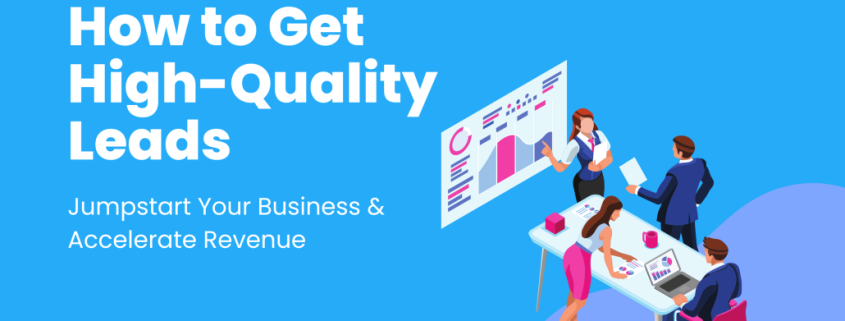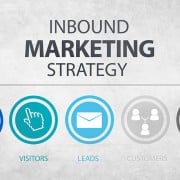How to Get High-Quality Leads for Your Business
Continuously generating new leads is key to a profitable B2B business. The more leads you receive, the more opportunities you’ll have to create and close deals for your product or service. However, if the leads you’re working with are not qualified to purchase, your sales team could be wasting their time targeting the wrong prospects— struggling to meet revenue goals and limiting your company’s success. After all, generating all the leads in the world means nothing if they are not a good fit for your business. To avoid this and combat some of the struggles associated with prospecting and sales, this article will review the definition of an inbound lead, provide tips on identifying the good ones, and discuss different marketing strategies to get high-quality leads for your business.
Download Now: Lead Acceleration Guide
What is a lead?
Each business may have a different definition of a lead for their company; some may not even call it a lead and use the term prospect instead. Regardless of the internal definition or how they’re labeled within a specific company, a lead generally shows some interest in learning more about or buying a product or service. Inbound leads are those that come to you and are created after submitting their personal information on your website.
Examples of leads opening lines of communication with your business include:
- Signing up for a free trial
- Submitting on a contact form
- Requesting access to a downloadable offer
Unlike purchased lead lists that receive cold calls and cold email outreach, inbound leads are generally contacted by the sales reps after they’ve expressed some interest.
Identifying High-Quality Leads
Before you can attract high-quality leads you will need to identify what qualifies as such. With the help of your sales and marketing team and customer base, define what a lead is for your business and create buyer personas for each lead type.
Lead Definition
The process of defining a lead for your company usually (or should) involve both Sales and Marketing. This process is often called Sales and Marketing Alignment and it’s important that both teams agree on the following items:
- What a lead is and how you will define it
- The various stages of a lead
- What buyer-centric actions will move them to the next lead stage
- Who will be assigned the lead at each stage
As mentioned previously, not all leads will be a good fit for your business. Identifying these good-fit leads early in the sales process will help you understand where you should focus your time and efforts. By creating a lead process with clear definitions and stages and aligning your sales and marketing efforts around the common goal of revenue growth, you’ll be able to identify quality leads early, define and set expectations between teams, and achieve revenue goals for your company.
Buyer Personas
The next step in identifying quality leads is to create buyer personas for your business. Buyer personas are fictional representations of your ideal customers used for segmentation, content mapping, and lead nurturing. These personas will give you and your team a better understanding of your ideal prospects and customers while making it easier for you to create content tailored to their specific needs, behaviors, and challenges. For example, instead of sending the same lead nurturing emails to everyone in your CRM, you can segment your email lists by buyer persona and tailor your messaging according to what you know about those different personas. Conduct surveys or interview your existing customer base and your marketing and sales team to develop your buyer personas — depending on your business, you may have two, ten, or even 20 personas.
Expert Tip: Add required fields to forms on your website that capture important persona information to gain insight into company size, industry, and their position in the business.
Here’s an example of how you can develop your first buyer persona to identify a good-fit lead and the information you should be collecting:
Persona Name: CEO Brenda
BACKGROUND
- What is their job?
- Career path?
- Do they have a family?
DEMOGRAPHIC
- What is their age?
- Annual income?
- Location?
GOALS
- Secondary goal?
- What is their primary business goal?
CHALLENGES
- Primary challenge?
- Secondary challenge?
WHAT CAN WE DO
- How can we help our persona achieve their goals?
- How can we help our persona overcome their challenges?
COMMON OBJECTIONS
- Why wouldn’t they buy your product/service?
How to Qualify a Lead
Once you’ve defined what a lead is and identified what an ideal prospect and customer looks like for your company, the next step to getting high-quality leads to your site is to qualify them. Qualifying prospects for mutual fit is critical for any successful sales strategy, but what if you could gather critical information about the lead before they are handed off to sales? The qualification process begins with understanding the journey they took to get to this point of conversion— using a combination of website forms and lead scoring, you can achieve just that.
Forms
Every form on your website tells a story. Forms collect vital information, determine the visitors’ level of interest, and, when executed correctly, are an essential tool for qualifying leads. Whether you are offering a piece of gated content like a whitepaper, ebook, or free lead generation acceleration guide, gearing up talent acquisition efforts for your business, or offering a free 90-day subscription to your software, collecting the right information will help you gauge their level of interest and where they are in the buyer’s journey. Form fields will vary depending on the type of content you’re offering, buyer persona, business type, etc. How much information will vary depending on your business type.
Here are a few basic examples of what to include in a lead generation form:
- Name
- Company
- Position
- Location
Lead Scoring
Lead scoring is the process of ranking your leads on a scale based on their perceived value in the organization. Lead scoring assigns numerical values to prospect behaviors and the resulting score will help you sort the high-quality leads from the ones that aren’t a good fit and need to be nurtured until they are ready. Assign scores to email subscriptions, web page views, form submissions, conversions, or social media engagement. The higher the engagement, the higher the score, the more qualified the lead, and the increased chances of closing the deal.
Lead Generation Strategies to Get High-Quality Leads
Blog
Inbound marketing starts with attracting visitors. Attracting visitors to your business is all about creating and promoting engaging, valuable content that informs rather than tries to sell. Content is king and is key to the get high-quality leads and traffic you need to generate sales. By providing targeted, relevant content at the right time, you can increase online visibility and awareness, be known as a thought leader in your industry, and ultimately build trust with your prospects.
Algorithms for popular search engines like Google SERPs are becoming increasingly sophisticated. Finding your way to the first page of search results will depend greatly on your ability to create authoritative content— natural, well-written, and informative content. By developing the right campaign to run alongside your blog strategy, you’ll be able to increase organic traffic and generate more conversions.
SEO
The process of posting blogs, just to post blogs, isn’t going to drive the necessary traffic to obtain the quality leads you’re looking for. Even if you’re producing high-end content, your ability to reach potential readers will depend heavily on your content strategy and SEO efforts. Before you publish, ask yourself:
Does my blog content include the following?
- Keyword Phrase
- Featured Image
- Meta Description
- SEO Title
- 800-1,000 words at a minimum
- Link to credible sites
Social Media
Once your content strategy is in place the next step is to promote. With over 4.55 billion people on social media, 82% of marketers said they are repurposing their content across their social media channels. Determine where your audience is and utilize those channels to maximize reach and produce results. Social media platforms make it easy for your followers to find and share your content— promote your latest blog article or include a call-to-action to one of your offerings.
Email and Newsletter
An email was designed to not only keep your audience informed and updated but also to give you leverage to nurture subscribers and build the kind of trust that is essential for them to purchase from you. Here are a few tips to create high-quality emails that convert:
1. Use your name in the “from” section of your email
2. Balance newsletters with 90% informative content and 10% promotional content
3. Include a short subject line and text preview
4. Set subscribers’ expectations at the start
5. Choose the main call-to-action
Still unsure about how to get high-quality leads for your business? Contact our team to learn more about inbound marketing and how your business can benefit from an inbound strategy today.
Ready to generate more qualified leads, boost conversions, and increase sales for your business? Download our free lead generation acceleration guide — 10 Steps to Increase Lead Generation and get started!











